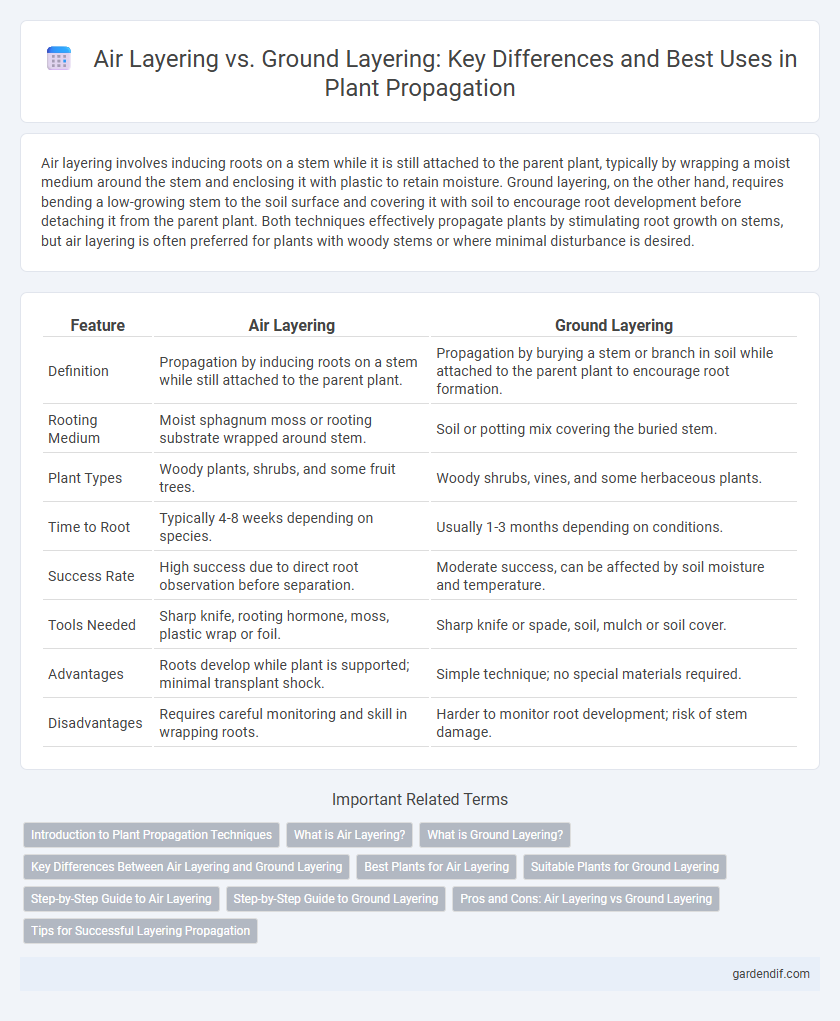
Air Layering vs Ground Layering Illustration
Air layering involves inducing roots on a stem while it is still attached to the parent plant, typically by wrapping a moist medium around the stem and enclosing it with plastic to retain moisture. Ground layering, on the other hand, requires bending a low-growing stem to the soil surface and covering it with soil to encourage root development before detaching it from the parent plant. Both techniques effectively propagate plants by stimulating root growth on stems, but air layering is often preferred for plants with woody stems or where minimal disturbance is desired.
Table of Comparison
| Feature | Air Layering | Ground Layering |
|---|---|---|
| Definition | Propagation by inducing roots on a stem while still attached to the parent plant. | Propagation by burying a stem or branch in soil while attached to the parent plant to encourage root formation. |
| Rooting Medium | Moist sphagnum moss or rooting substrate wrapped around stem. | Soil or potting mix covering the buried stem. |
| Plant Types | Woody plants, shrubs, and some fruit trees. | Woody shrubs, vines, and some herbaceous plants. |
| Time to Root | Typically 4-8 weeks depending on species. | Usually 1-3 months depending on conditions. |
| Success Rate | High success due to direct root observation before separation. | Moderate success, can be affected by soil moisture and temperature. |
| Tools Needed | Sharp knife, rooting hormone, moss, plastic wrap or foil. | Sharp knife or spade, soil, mulch or soil cover. |
| Advantages | Roots develop while plant is supported; minimal transplant shock. | Simple technique; no special materials required. |
| Disadvantages | Requires careful monitoring and skill in wrapping roots. | Harder to monitor root development; risk of stem damage. |
Introduction to Plant Propagation Techniques
Air layering and ground layering are two effective plant propagation techniques that enhance root development on stem sections before separation from the parent plant. Air layering involves wounding a stem, applying rooting hormone, and wrapping it with moist medium, which promotes root growth while the branch remains attached. Ground layering entails bending a low branch to the soil, burying a portion while keeping the tip exposed, encouraging root formation at the buried section for subsequent severing.
What is Air Layering?
Air layering is a propagation technique that involves inducing roots on a stem while it is still attached to the parent plant by wounding the stem and wrapping it with moist sphagnum moss and a protective covering. This method encourages root development in a controlled environment, allowing the new plant to be separated once substantial roots have formed. It is particularly effective for woody plants and species that are difficult to root from cuttings.
What is Ground Layering?
Ground layering is a propagation technique where a flexible stem is bent to the ground and covered with soil to encourage root development while still attached to the parent plant. This method promotes the formation of roots at the buried section, allowing the new plant to grow vigorously once separated. Commonly used for shrubs and vines, ground layering ensures higher success rates due to continuous nutrient supply from the parent plant during root establishment.
Key Differences Between Air Layering and Ground Layering
Air layering involves inducing root growth on a stem while it is still attached to the parent plant, using moist medium wrapped around the wounded section, whereas ground layering requires bending a low-growing stem to the soil and covering it to encourage root development. Air layering is preferred for woody plants and produces new plants faster, while ground layering is commonly used for soft-stemmed plants and generally takes longer to root. The primary difference lies in the location of root formation--above ground and on the stem for air layering versus below ground in contact with soil for ground layering.
Best Plants for Air Layering
Air layering is most effective for woody plants such as magnolias, camellias, rubber plants, and fruit trees like figs and guava, which develop roots more readily from stem tissue. Unlike ground layering that works well for vines and herbaceous plants, air layering is preferred for species with thicker stems and slower root formation. This propagation method enhances root success rates in species with tough bark or those difficult to root via cuttings, making it ideal for ornamental shrubs and tropical plants.
Suitable Plants for Ground Layering
Ground layering is ideal for vigorous, spreading plants such as blackberries, raspberries, and certain roses that naturally produce trailing stems close to the soil. Hardy shrubs like forsythia, honeysuckle, and lilac respond well to ground layering, allowing new roots to develop on buried stems. This method suits plants with flexible stems and a strong root system, ensuring successful propagation through natural layering processes.
Step-by-Step Guide to Air Layering
Air layering requires selecting a healthy branch, making a circumferential cut or removing a ring of bark, and applying rooting hormone to encourage root development. Next, wrap the wound with moist sphagnum moss and cover it with plastic wrap or aluminum foil to retain moisture and protect roots as they form. Once roots appear through the moss, typically after 4 to 8 weeks, cut below the rooted area and plant the new rooted branch in soil for independent growth.
Step-by-Step Guide to Ground Layering
Ground layering involves selecting a low branch, wounding it by removing a strip of bark, and then covering the wounded section with moist soil while keeping it anchored to the parent plant. Regular watering ensures root development within the buried node, typically taking several weeks to months depending on the species and environmental conditions. Once roots establish, the new plant can be severed from the parent and transplanted, ensuring successful propagation with minimal stress.
Pros and Cons: Air Layering vs Ground Layering
Air layering enables faster root development and higher success rates in propagating difficult woody plants, but it requires more skill, time, and materials compared to ground layering. Ground layering is simpler, less labor-intensive, and can produce multiple new plants per parent, though it generally takes longer and has lower success rates for woody species. Choosing between air layering and ground layering depends on plant type, available resources, and desired propagation speed and efficiency.
Tips for Successful Layering Propagation
Ensure the air layering site remains consistently moist by wrapping sphagnum moss around the wounded stem and covering it with plastic to retain humidity. For ground layering, select a flexible, healthy branch and secure it firmly to the soil using U-shaped pins or stones to encourage root development. Monitor both methods regularly for signs of root growth before severing the new plant from the parent to maximize propagation success.
Air Layering vs Ground Layering Infographic

 gardendif.com
gardendif.com